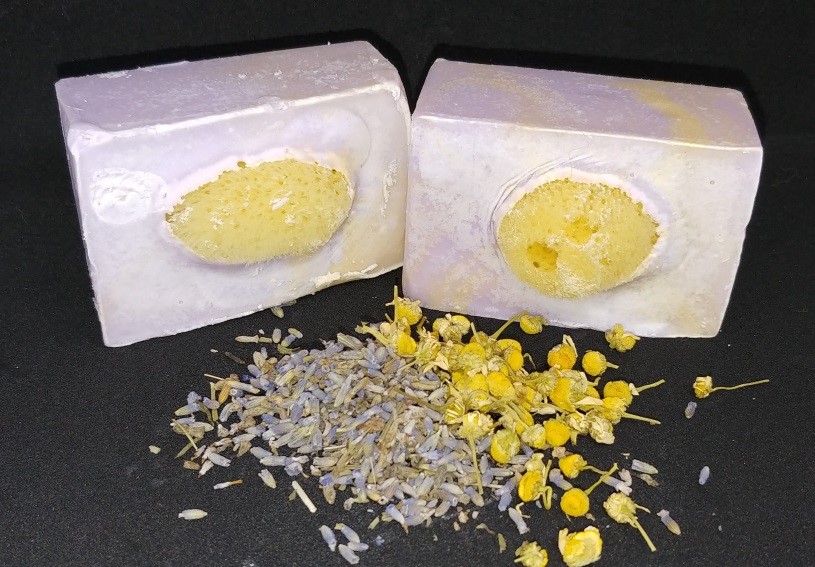12 June, 2017
0 Comments
1 category
Handcrafted soap has 3 basic ingredients – Oils, Water, and Lye. It is the chemical reaction between the 3 that produces soap. Other ingredients can be added to color, scent, or provide additional benefits to the soap. This blog post will describe the ingredients in soap, and compare them with ingredients in commercial soaps.
Handmade soap ingredients:
- Common Oils – common soapmaking oils include Coconut oil, Olive oil, Palm oil, Sunflower oil, Castor oil, Safflower oil, and Canola oil. Each oil provides different benefits to the soap – better bubbles, harder bar, skin conditioning. The combination of oils is determined by the end product desired, as different oils provide different benefits.
- Specialty oils – Avocado oil (wonderful emollient, great for mature skin), Grapeseed oil (rich in linoleic acid, for a mild soap that conditions the skin), Sweet almond oil (non-greasy oil good for a variety of skin types, and helps the skin to retain moisture), jojoba oil (one of the most expensive oils, but one of the best to enhance moisture in the skin because it is most like the natural oil in your skin), cocoa butter (lays down a protective layer on the skin to hold moisture in the skin), shea butter (a good moisturizer, which has a high percentage of unsaponifables, so it survives the chemical reactions of soapmaking and is left in its original state within the bar of soap. Reported that is protects the skin from the harmful effects of the sun and helps heal scars), and mango butter (highly prized oil to moisturize skin, and like shea butter has a high percentage of unsaponifables, and is used to protect skin from harmful sun effects and heal scars).
- Lye (Sodium Hydroxide) – Lye is a strong and caustic base, which must be handled carefully because it can burn the skin. It is a necessary ingredient in soapmaking, as it creates a chemical reaction with the oils and water, to make soap. Lye becomes neutralized during the saponification (soap creating) process and is no longer caustic after the soap cures, which takes 4-6 weeks.
- Water – distilled water is used in soapmaking, because it is water that has had the impurities removed through distillation. Water also evaporates out of the soap as it cures, creating a hard bar of soap
- Glycerin – glycerin is a humectant, which means that it draws moisture into the skin. It is a natural byproduct of soapmaking. Commercial manufacturers remove the glycerin for use in their more profitable lotions and creams, but handcrafted soap retains glycerin in each and every bar
- Exfoliants – one of the benefits of handmade soap is that a variety of ingredients can be added to exfoliate, or scrub the skin to remove dead and dry skin. Common natural exfoliants are Cinnamon, Cornmeal, lavender, lemongrass, tea, coffee grounds, pumice, oats, seeds (poppy, grape, berry), walnut shells, loofah, orange peel
- Colorants – Colorants for soap can be natural or artificial. Natural colorants include herbs, spices, flowers, clays, spirulina, charcoal or cocoa. However, the range of colors from natural ingredients is limited, so many soapmakers use synthetic colors made from minerals, oxide pigments, micas, or dyes in order to create brighter colors
- Scents – Soap can be scented with natural essential oils, or artificial fragrance oils. Essential oils are concentrated oils extracted from plant leaves, flowers or berries. Artificial fragrance oils are generally less expensive than essential oils, but if cosmetic grade can be safely used in soaps and skin care products.
Commercial soap ingredients (I used Dove sensitive skin unscented beauty bar as an example):
- Sodium Lauroyl Isethionate – Used as an emulsifier (helps oils and water to mix together) in soap, as it is less expensive that using natural oils and glycerin as emulsifiers. This soap ingredient does not appear to have any beneficial properties for your skin (aside from cleaning it), and may dry it out.
- Stearic Acid – Used as a hardener in soap. It may cause sensitivities in people with allergies
- Sodium Tallowate – Used for cleansing. This inexpensive and readily available soap ingredient cleanses and moisturizes your skin, and is used as a substitute for more expensive natural oils
- Sodium Palmitate – Used for cleansing and creating lather. This soap ingredient cleanses your skin, but may dry it out.
- Lauric Acid – It is a surfactant and cleansing agent. Lauric Acid occurs naturally in some vegetable oils like palm oil. It is used to cleanse the skin.
- Sodium Isethionate – Generally used as a surfactant (detergent). This ingredient is mild on the skin and non-drying. It produces a lot of dense lather.
- Water
- Sodium Stearate – The Stearate salts are generally used for their lubricating properties.
- Cocamidopropyl Betaine – Used as a surfactant (detergent). This is generally regarded as one of the more gentle surfactants
- Sodium Cocoate – This is a gentle surfactant, or a detergent. This ingredient cleanses your skin
- Sodium Palm Kernelate – This is a gentle surfactant (detergent). This ingredient cleanses your skin
- Sodium Chloride – Used as a thickening agent. Sodium Chloride is the same as ordinary table salt
- Tetrasodium EDTA – Used as a preservative. This ingredient does not appear to have any beneficial properties for your skin. True soaps, made from oil, lye and water, don’t generally require preservatives
- Maltol – Used as a flavoring agent. This ingredient does not appear to have any beneficial properties for your skin. It might be used as a fragrance, but maybe not considering Dove claims this bar to be unscented.
- Titanium Dioxide – Used as a natural whitening agent. Titanium Dioxide is thought to have no negative side effects when used externally.
Just as in my food, I would prefer to use substances I can pronounce, and that have definite beneficial qualities for my body. Do your own comparison with handmade and commercial soaps, and see the difference in how your skin feels!


